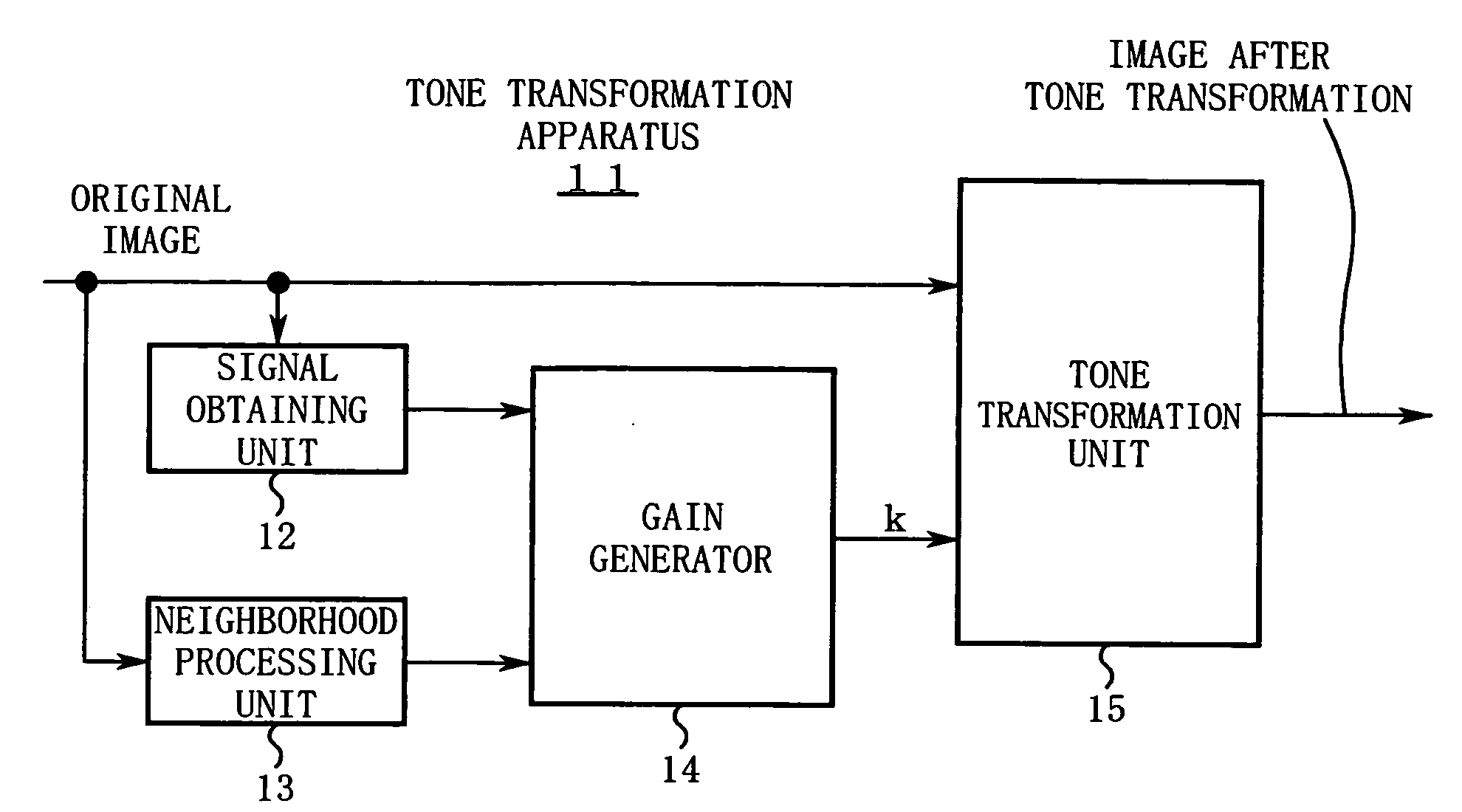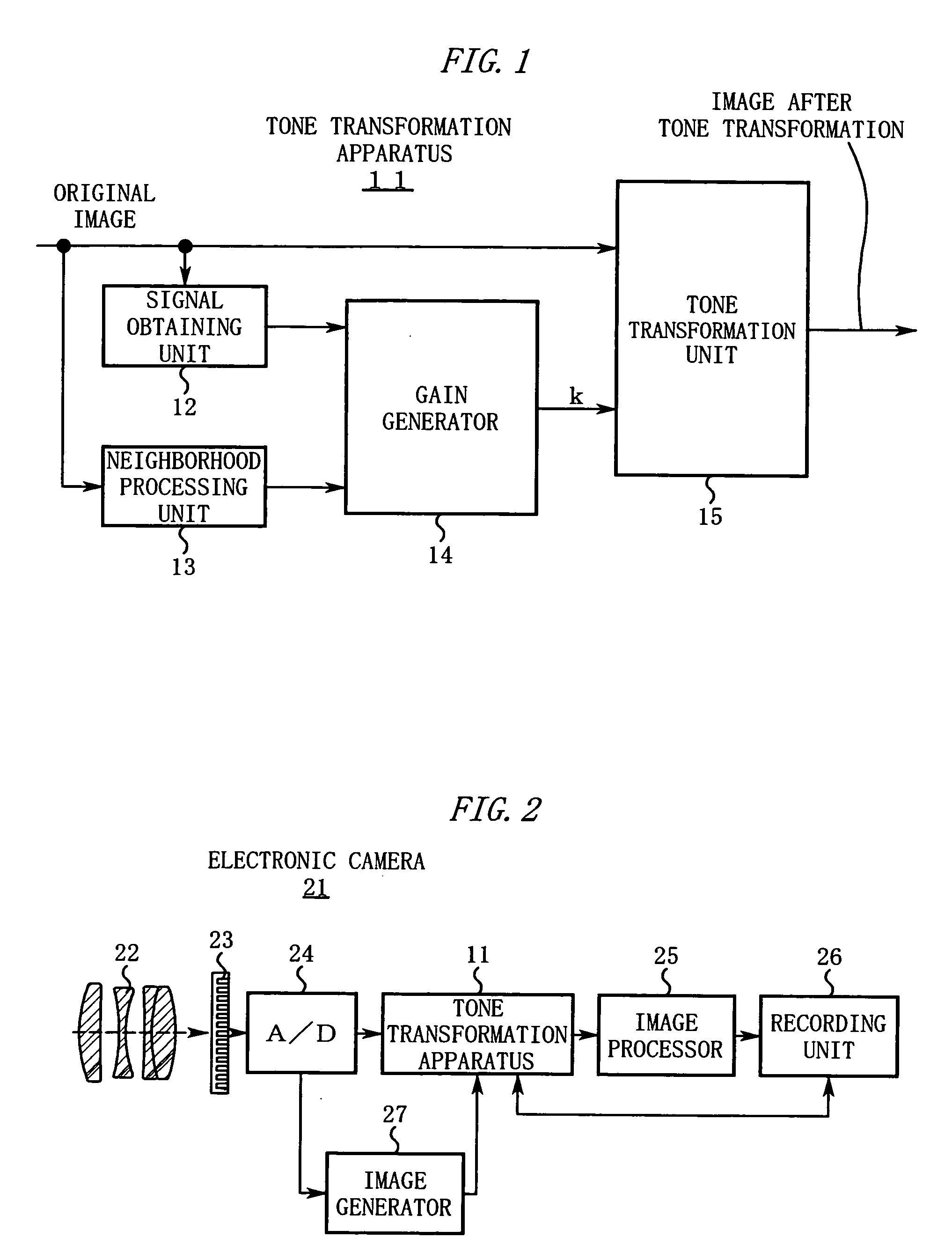Apparatus, program, and method for image tone transformation, and electronic camera
a technology of image tone and program, applied in the field of apparatus, program and method for image tone transformation, can solve the problems of excessive exaggeration of shadows, difficult to perform delicate processing, and prior art cannot realize image processing, and achieve the effect of well-balanced adjustment of brightness/darkness balance and tone ris
- Summary
- Abstract
- Description
- Claims
- Application Information
AI Technical Summary
Benefits of technology
Problems solved by technology
Method used
Image
Examples
first embodiment
>
[0059]FIG. 1 is a diagram showing a configuration of a tone transformation apparatus 11.
[0060] In FIG. 1, the tone transformation apparatus 11 includes the following constituent features: [0061] (1) a signal obtaining unit 12 to obtain a signal Z indicating brightness or the like of each pixel of an original image. [0062] (2) a neighborhood processing unit 13 to extract a neighborhood area from each pixel of the original image and processes pixels in the neighborhood area to obtain a signal ZL. [0063] (3) a gain generator 14 to find a transformation gain k for each pixel according to the signal Z and the signal ZL. [0064] (4) a tone transformation unit 15 to transform the tone by multiplying a signal of each pixel of the original image by the transformation gain k for each pixel.
[0065] The above-described tone transformation apparatus 11 may be partly or entirely composed of hardware. Alternatively, the tone transformation apparatus 11 may be realized on a computer as software by...
case 1
(case 1) When R, G, and B are the plural color components composing the original image, R′, G′ B′ signals resulting from the transformation using the transformation gain are calculated by the following.
R′=k·R, G′=k·G, and B′=k·B
case 2
(case 2) In a case of a brightness signal indicating luminance or an amount of brightness and input signals indicating a plurality of color differences, the brightness signal is multiplied by the transformation gain k, whereby a brightness signal after the tone transformation is calculated. Further, color differences C1′, C2′ after the tone transformation are calculated by
C1′=k·C1 and C2′=k·C2,
where C1 and C2 are the input signals indicating the plural color differences.
[0122] Some tone transformation is accompanied by a change in visual saturation. For correcting this saturation change, a transformation gain k1 after correction is used instead of the transformation gain k.
C1′=k1·C1 and C2′=k1·C2
[0123] Here, the transformation gain k1 after the correction is found by
k1=k·t(Z) or k1(Z, ZL)=k(t(Z), ZL),
where t(Z) is a function monotonically changing with respect to Z. Note that the function t(Z) is preferably determined based on experiments so that the visual saturation become...
PUM
 Login to View More
Login to View More Abstract
Description
Claims
Application Information
 Login to View More
Login to View More - R&D
- Intellectual Property
- Life Sciences
- Materials
- Tech Scout
- Unparalleled Data Quality
- Higher Quality Content
- 60% Fewer Hallucinations
Browse by: Latest US Patents, China's latest patents, Technical Efficacy Thesaurus, Application Domain, Technology Topic, Popular Technical Reports.
© 2025 PatSnap. All rights reserved.Legal|Privacy policy|Modern Slavery Act Transparency Statement|Sitemap|About US| Contact US: help@patsnap.com



